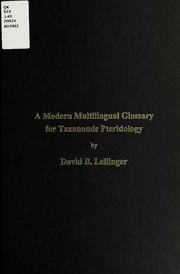
A modern multilingual glossary for taxonomic pteridology PDF
Preview A modern multilingual glossary for taxonomic pteridology
A Modern Multilingual Glossary for Taxonomic Pteridology by David B. Lellinger Department ofBotany National Museum ofNatural History Smithsonian Institution DC Washington, 20560-0166 Spanish translation by Cristina H. Rolleri Museo de La Plata, La Plata, Bs. As., Argentina French translation by Christian Feuillet DC Smithsonian Institution, Washington, Portuguese translation by Paulo G. Windisch Universidade do Vale do Rio dos Sinos, São Leopoldo, RS, Brazil American Fern Society, Inc. . QK 513 U4 5 Copyright 2002 by the 2-0 0 American Fern Society, Inc. Library of Congress Cataloging-in-Publication Data Dellinger, David B. A modern multilingual glossary for taxonomic pteridology / by David B. Dellinger; Spanish translation by Cristina H. Rolleri, French translation by Christian Feuillet, Portuguese translation by Paulo G. Windisch. p. cm. -- (Pteridologia 3) ; Includes bibliographical references (p. ) ISBN 0-933500-02-5 $28.00. : 1. Pteridophyta- -Dictionaries- -Polyglot Dictionaries, . Polyglot. I. Title. II. Series: Pteridologia 3. ; QK523.L45 2002 2002007337 587/. 03 21 ISBN 0-933500-02-5 Pteridologia 3 Published 5 August 2002 Printed in the United States ofAmerica DEDICATION To the memory of William Ralph Maxon (1877-1948) and Warren Herbert Wagner, (1920-2000) Jr. principal American pteridologists of the first and second halves of the twentieth century CONTENTS 5 CONTENTS Contents 5 Introduction 17 References consulted 32 Figure (lA) Symmetry 34 (IB) General form 35 (IC) Solid forms (ICl) Indeterminate forms 37 0C2) Determinate forms 37 0C3) Rolling or folding of solid forms 40 (1C4) Sections of solid forms 40 (ID) Plane forms (IDl) Complete forms 42 0D2) Partial forms 47 (1D3) Base forms 48 D4) Apex forms 51 (1 Order and division (2A) Order 55 (2B) Branching patterns 57 (2C) Dimorphism of fronds and their parts 58 (2D) Architecture of fronds and their parts 59 (2E) Division ofthe lamina 62 (2F) Incision ofthe lamina or other structures 65 (2G) Margin ofthe lamina or other structures 67 Position (3A) Series 71 (3B) Proximity to other structures 71 (3C) Dispersion ofsimilar structures 74 (3D) Divergence of similar structures 74 (3E) Position of appendages relative to a surface 75 (3F) Arrangement of lateral structures along an axis 76 (3G) Position relative to an apex, axis, or margin 77 (3H) Position between an axis and a margin 82 (31) Position of sori and veins relative to the lamina surface 83 Growth (4A) Development (4A1) Maturation through time 85 (4A2) Maturation through space 86 (4A3) Continuity ofdevelopment 87 (4A4) Underdevelopment 88 (4A5) Overdevelopment 89 (4B) Attachment 90 (4C) Persistence 92 CONTENTS 6 Substance (5A) Fragility 94 (5B) Thickness and texture 94 (5C) Transparency 96 (5D) Visibility 97 Surface (6A) Color and pattern 98 (6B) Appearance or coating ..99 (6C) Surface forms 101 (6D) Indûment (6D1) Absence of indûment 103 (6D2) General types 103 (6D3) Hair and gland types 107 (6D4) Branched hair types 110 (6D5) Hairs and bristles in mass 113 (6D6) Scale types 116 (6D7) Scales in mass 120 (6D8) Structures 121 Gametophytes (7A) General 123 (7B) Types 125 (7C) Gametangia and gametes 126 Sporophytes (8A) General 128 (8B) Habit.. 131 (8C) Roots 133 (8D) Rhizomes and other stems (8D1) Types 134 (8D2) External features 136 (8D3) Absolute position 139 (8D4) Position relative to the soil or water surface 141 (8E) Fronds and microphylls (8E1) Types 142 (8E2) Attributes 143 (8F) Axes (8F1) Types 147 (8F2) Structures 149 (8F3) Attributes 155 (8G) Laminae (8G1) Structures 158 (8G2) Attributes 163 (8H) Venation (8H1) Dromy 165 (8H2) Pattern 166 (81) Sori 170
